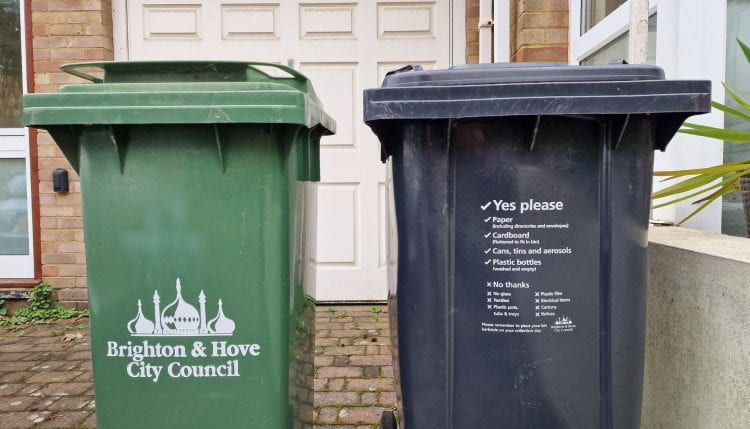
Your ultimate guide to eco-friendly recycling in Brighton and Hove
New to living in shared houses or flats? Want to make a positive impact on the environment in Brighton and Hove? Recycling is a simple yet effective way to reduce your carbon footprint and contribute to a cleaner, greener city. However, sorting your rubbish correctly and avoiding contamination of recycling bins can be a bit tricky. In this guide, we’ll walk you through the best way to recycle and sort your waste according to the Brighton and Hove City Council (B&HCC) guidelines while keeping contamination at bay. Alternatively, see this handy PDF guide on recycling.
Know Your Bins
Brighton and Hove City Council provides colour-coded bins to help you easily identify the type of waste they are meant for:
Green Bin: This is for general household rubbish like plastic food wrappers and food scraps. Please ensure your rubbish is contained within a bag or sack. Avoid overfilling these bins to stop local wildlife like seagulls and foxes opening these bags. For multiple occupancy houses, you can order a larger bin from the council.
Black Bin: The black bin is for recyclable items like:
- tins and cans – empty and washed, with metal lids on
- aerosols – empty with lids removed
- cardboard – flattened and folded so that it fits into the box
- paper – including magazines and windowed envelopes
- plastic bottles – washed and squashed, with their lids, pumps and triggers

Small kerbside box: Glass bottles and jars (with their metal lids on) should be placed in the kerbside box. Note that broken glass should be securely wrapped and placed in the green bin. If missing a kerbside box, order a new one from the council.
Communal Recycling Bin: These large black bins located on the street accept the recycling items of: Tins and cans; Aerosols; Cardboard; Paper; and plastic bottles.
Brown Bin: these are only used for garden waste, such as grass cuttings and leaves. Avoid placing soil, stones, or larger branches in this bin, as they can contaminate the load.
If you’re still not sure what can be recycled, check out this B&HCC website.
 Glass bottles and jars
Glass bottles and jars
The kerbside box is perfect for glass bottles and jars. Just make sure they’re rinsed and free from any contamination. Be sure to re-attach any metal lids for disposal too.
Batteries and vapes
These items contain hazardous materials so please do not put in any bin. Instead, batteries and vapes can be recycled at household waste recycling sites and some larger supermarkets.
Many household electrical items, including vapes, hearing aids and laptops, contain a hidden lithium battery that can be extremely dangerous when thrown away. Before recycling electrical items, always check to see if the battery can be removed to recycle separately.
Electrical items
Used electrical items – take small items to 10 recycling points, and larger items to our recycling sites. There’s also a collection service – check this website for details.
Food waste
The green bin is designated for food waste. This includes food scraps, peelings, teabags, and even pet food. However, if you have tins or packets of food going spare then why not donate them to Brighton and Hove Food Partnership.
Clothes and shoes
There are 60 textile banks located at most of our recycling points.
Learn the collection schedule
Brighton and Hove council has specific collection schedules for each type of waste. Be sure to check the council’s website or contact them to find out when your bins and boxes are due for collection. This helps ensure you don’t miss a pickup and reduce the risk of overfilled bins.
And, only put out your bins for collection on the evening before.
Contamination is a no-go
Contamination happens when non-recyclable items are mixed with recyclables, rendering the entire load unrecyclable. Be vigilant about what you put in your recycling bins. Even a small amount of contamination can result in the entire bin being rejected.
- Keep glass separate from your other recycling. When glass gets mixed with other materials, it has to be treated as general waste.
- Reuse plastic bags and put in your general waste when they’re no longer usable. Plastic bags are not recyclable.
- Put yoghurt pots, butter/spread tubs and food trays in your general waste. These low grade plastics like these cannot be recycled locally.
- Don’t put tetrapak cartons in your recycling. You can recycle cartons at 20 recycling points and two recycling sites.
Recycle Smart
Recycling smart means not just putting everything in the black bin but also rinsing your recyclables and ensuring they are clean. A quick rinse helps to prevent contamination and makes the recycling process more efficient.
By following these guidelines, you can make a significant impact on recycling in Brighton and Hove while also contributing to a cleaner, more sustainable environment. So, get your housemates involved, spread the word, and let’s make our beautiful city even more eco-friendly one recyclable item at a time.
Remember, recycling is not just about sorting your rubbish; it’s a collective effort to protect the environment and ensure a brighter future for all of us. So, be a responsible university student and start recycling the right way today!
